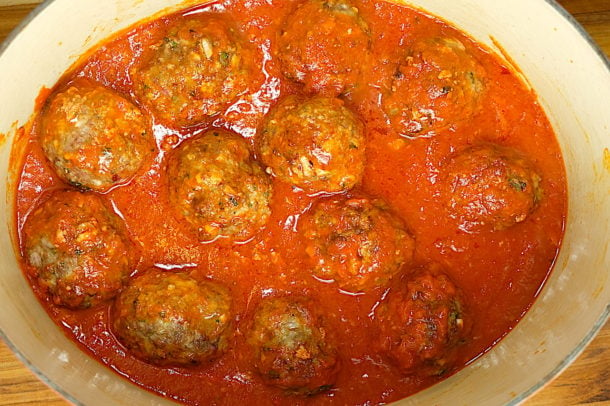My Low-Acid Marinara Sauce recipe is foolproof, simple, and straight forward. I have several people in my family sensitive to acidic foods and so I have developed a few life hacks to help neutralize the acids in our diet. I’ll give you several options on how to customize the sauce and the meal to make it your own Low-Acid Tomato Sauce.
How to make Tomato Sauce Less Acidic
If you’re just Googling ‘How To Make Marinara Sauce Less Acidic’ for a quick and easy answer on how to make it less acidic, here it is; 1/2-teaspoon baking soda to one jar of sauce. Haha, no need to read any further, people have been using baking soda to relieve heartburn for decades. Tomatoes are very acidic, with a pH of around 6-6.8. The downside to using baking soda to neutralize the acid in tomato sauce is that it can ruin the flavor of the sauce if you use too much. Therefore, if you’re a cook like me, and looking for other foods that help neutralize stomach acid, keep reading!
Tomatoes are very acidic, with a pH of around 6-6.8
For my Low-Acid Marinara sauce recipe I use fresh herbs in the summer when my garden is growing, and dry herbs in the winter. Fresh basil should be used right at the end of cooking so the flavor is fresh and bright, whereas the dry herbs can handle the 30-minute cooking time. Depending on your preference, you can add additional liquid to the sauce, for meatballs only, I prefer the sauce a little drier, if your adding pasta to the sauce, a little pasta water will be a welcome addition.
This is the same Marinara sauce recipe that I’ve used in several other recipes. It is quick and easy, costs less than half of what I spend on a jar of sauce, and tastes twice as good. So, for five minutes’ worth of work, you get a sauce that is infinitely better than any sauce you get in a jar.
Can Low-Acid Tomato Sauce Be Modified?
Yes! Although technically speaking, I believe that Marinara Sauce should just be a basic tomato sauce. Once you add other ingredients it probably has another name. I make this basic sauce frequently and change it up quite a bit. Here are some of my modifications:
- Beef and Mushroom Sauce. ½-pound of browned ground beef and 1-pound of sautéed sliced mushrooms make an amazing spaghetti sauce
- Spinach and Mushroom Sauce, 1-pound sautéed sliced Cremini mushrooms and 5-ounces of fresh baby spinach added just at the end make a light and fresh sauce
- Lasagna Sauce. I add ½-cup sliced green olives, ½-cup sliced black olives, ½-pound browned Italian Sausage, ½-pound browned ground beef or pork. Layered between sheets of pasta, and a combo of mozzarella, ricotta, and parmesan cheeses, it’s pure Heaven.
- Vodka Sauce. Add ¼-cup Vodka and ½-Cup Heavy Cream
- Sensitive Stomach Low-Acid Marinara Sauce.
Reducing Acidity in Tomato Sauce
Tomato sauce and pasta are naturally acidic. To counteract this you need to add naturally alkaline ingredients to bring the PH down to help neutralize the acid in food. While at the same time not dramatically changing the flavor, or look of the Low-Acid Marinara Sauce. Although garlic is alkaline, many people find it irritating, you can reduce or eliminate it from the recipe if needed.
I’m not a Doctor, I’m just a cook, so take this information with a grain of salt, and consult with your doctor if you have concerns about any of these ingredients or suggestions.
Here are some of my tips for a Less Acidic Sauce and some foods that neutralize stomach acid.
- Pasta made with white, wheat, or Durum flour is highly acidic, substitute gluten-free pasta for a low-acid alternative. Since pasta is a main component, this is a quick and easy start to reducing the acid in the meal
- Garlic Bread: I’m sorry to be the one to tell you, but white flour is highly acidic. Garlic knots, toast, bread, etc. is one of the big problems with this meal irritating your stomach. If you can find a gluten-free garlic bread, that is the one for sensitive stomachs.
- Carrots are moderately alkaline. Adding ¾ -cup of finely grated carrots does not change the flavor and they disappear into the sauce after simmering.
- Celery is very low alkaline but does have a distinct flavor. I add 1 celery stalk that is finely grated and the flavor is not changed
- Fresh Garlic. Technically it is moderately alkaline, however, the pungency of fresh garlic and onions are irritating to people with sensitive stomachs. You can try substituting powdered garlic and onions in recipes that call for them to see whether that helps your particular stomach issues. I list it as optional in the recipe.
- Mushrooms are low alkaline. 8-ounces of finely chopped or pureed mushrooms will disappear into the sauce once cooked
- Flat-Leaf Parsley is moderately alkaline and is an excellent garnish and a great addition to a side salad
- Mineral Water is highly alkaline and since water is needed to thin the sauce anyway, you may as well add mineral water.
- Apple Cider Vinegar is less acidic than other types of vinegar, so use this for your salad dressing. And while you’re at it, work some of the carrots, celery, mushrooms, and parsley into your salad as well.
- Avoid House Dressings: I hate to be the one to tell you, but Ranch dressing is acidic, so are most vinaigrettes, French, House, Blue Cheese, etc. It’s a good idea to research your dressing choices if you have a sensitive stomach.
- Baking Soda. Many ‘low-acid’ Marinara Sauce recipes only use baking soda to help decrease the acidity. It’s a great easy fix, and a lot less work. The only thing I don’t like about this method is that it’s a little foamy, so put it into the sauce early in the cooking, so it has a chance for the bubbles to subside. I think working these other healthy options such as carrots, celery, apple cider vinegar, etc. is better for you in the long run. That being said, 1 ½-teaspoons of baking soda will help neutralize the acid.
What recipes can you make with this Marinara Sauce?
Turkey Meatballs in a Spinach & Mushroom Marinara
Meatballs with Green Pea Smashed Potatoes
Chicken Parmesan Meatball Sandwiches
My Homemade Margherita Pizza recipe
Here is my Low-Acid Marinara Sauce recipe:

Low-Acid Marinara Sauce
Ingredients
- 1 28-Ounce Can San Marzano Tomatoes -Crushed
- 1/2 Cup Mineral Water -Mineral Water is highly alkaline
- 3 Cloves Garlic -Optional, crushed and chopped
- 3 Tablespoons Olive Oil
- 3/4 Cup Carrots -Finely grated
- 1/4 Cup Celery -Finely grated
- 8 Ounces Mushrooms -Optional, finely chopped
- 1 Teaspoon Baking Soda
- 1-1 1/2 Teaspoons Salt
- 1/2 Teaspoon Red Pepper Flakes
- 2 Teaspoons Dried Oregano
- 2 Teaspoons Dried Basil -or 1/4 cup fresh basil, roughly chopped
- 1 Tablespoon Tomato Paste
Instructions
- In a large bowl, carefully crush the tomatoes by hand, they will squirt everywhere, so be gentle or you’ll be covered in tomato juice
- Rinse can with water to get all the sauce
- In a large skillet, heat the olive oil over medium-high heat, add the garlic and the tomato paste and cook briefly, just to get the raw flavor out of it, approximately 30-45 seconds
- Add the crushed tomatoes and sauce, and all remaining ingredients, unless you’re using fresh basil, then add it at the end after the heat is off
- Bring to a simmer, stirring frequently, simmer for approximately 30 minutes
